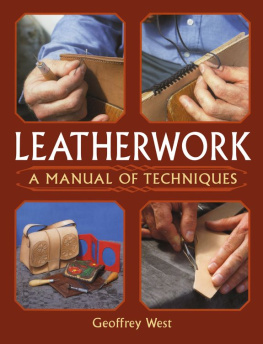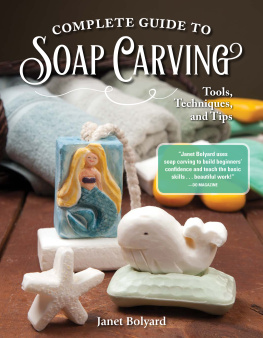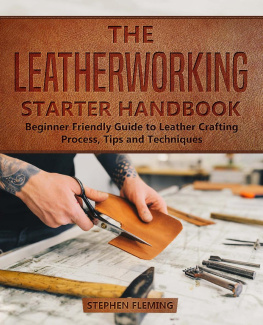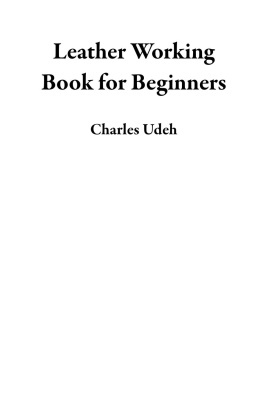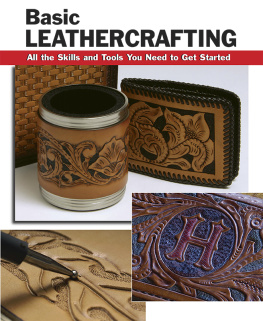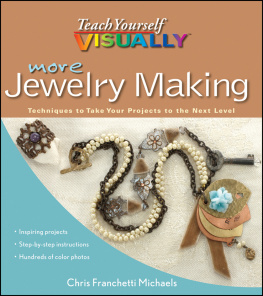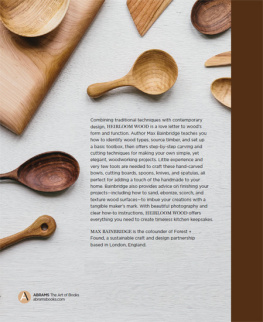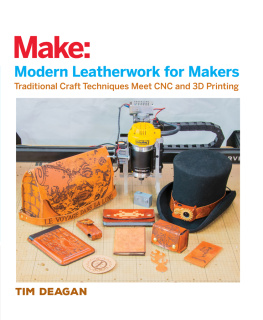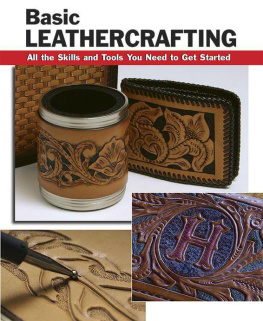To make straightforward items, and where time is of no account, only a few basic tools are required for leatherworking. While these can be obtained only from specialist suppliers, most firms offer mail-order services to long-distance customers. In addition to your basic range of tools you will need a fairly sturdy table set at a comfortable working height for either sitting or standing. Professional leather workers use a special (and expensive) purpose-built timber cutting board, but cutting can be done just as efficiently on a sheet of 9mm (in) or thicker medium-density fibreboard (MDF) or a cheaper purpose-built cutting board; plywood is not such a good choice, as the knife blades tendency to follow the grain (beneath the cutting line) may cause inaccuracy . Those who enjoy carving and dyeing thick leathers will require stamps, carving tools and various dyes and sealers, but if you are interested only in making light leather goods, such as wallets, soft handbags, tool pouches, and so on, a more basic selection of tools will suffice. The wisest initial option is to buy the minimum number of tools and increase the range as and when required.
Awls comprise a handle and a blade, the blade being permanently fixed in the handle. There are two types: the scratchawl and the stitchingawl.
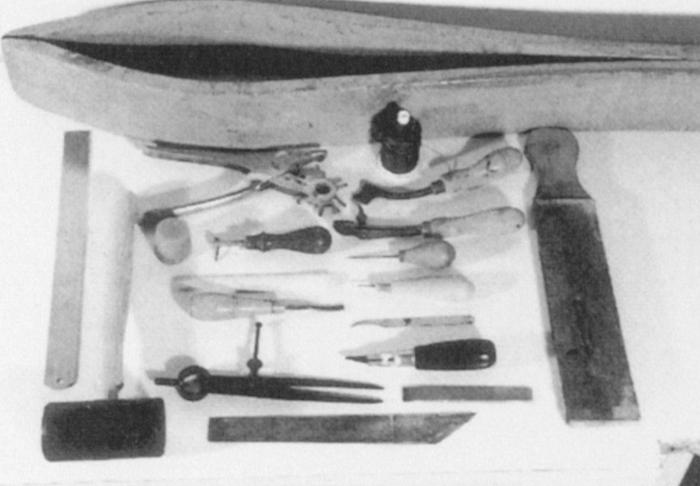
Fig1Basictools: (top) clam; (left) rulerandrawhidemallet; (right) sharpeningstrop; (middle clockwise from top) thread, stepcreaser, adjustablecreaser, scratchawl, stitchingawl, curvedbladeforclickerknife, clickerknifewithstraightblade, prickingiron, skivingknife, dividers, edgebeveller, bonefolder, stitchinggroover, beeswax, revolvingpunch-pliers.
The scratchawl has a round blade that tapers to a sharp point, similar to the sharp woodworkers bradawl, and it is used to stab location marks around leather pieces when cutting out and also as an aid when pattern-cutting . The stitchingawl has a diamond-shaped blade to pierce holes in leather so that the blunt needle can pass through. It is available as a wooden handle to which a separate blade is fitted by the user. Needles for leatherwork are not sharp, as they are not intended to pierce the leather, merely to enter a hole already made by the awl blade.
Bonefolder
This is a 15cm (6in) by 19mm (in) piece of tapered polished bone that curves slightly at its centre. It is used for flattening seams, or for turning over and pressing down leather edges. It is extremely useful for applying pressure uniformly along a line and for flattening corners.
Clickerknife
The short, 100mm (4in), tapering, cylindrical wooden handle has an adjustable, screw-tight socket for the insertion and attachment of blades. Curved and straight blades are available, the curved ones being useful for cutting around curves. To ensure accurate and efficient cutting, the best way to hold this knife is as a drawing pencil is held. Blades are sharpened occasionally on an oilstone and frequently on the for correct usage.
Creasers
These have handles, curved shafts and blunt blades, and are used to make decorative crease-marks on leather grain (top surface) at a predetermined distance from the edge. There are three types: adjustable screw, single and step, each of which works in a slightly different way. Single and step creasers are heated before use to allow the blade to make an acceptably deep impression. An adjustable screw creaser can be used either heated or cold, for marking a non-permanent line at a measured distance from an edge, for instance when marking out a line of stitches.
Cutting-board
A sheet of thick (9mm/in or thicker) MDF, or thick (12mm/in minimum) plastic-covered blockboard/particle board. Also available are plastic cutting boards and, for professional use, timber cutting boards that are composed of square wooden blocks glued together so that the grain edge forms the cutting surface: the spongy surface of the timbers end-grain does not blunt cutting tools (although blunting tools in use is not an issue unless much work is envisaged). Suitable sizes would be 915457mm (3618in) or 457457mm (1818in).
Dividers
These are adjustable double-pointed tools, similar to geometrical compasses. They are held as shown in for marking guidelines a precise distance from an edge (when hand stitching, thonging and pattern -making).
Edge-finisher
A plastic wheel with a semicircular groove around its circumference for ).
Hammer
This is used for flattening edges, turning seams, fitting metal fittings and attaching press-studs, and so on. A shoemakers hammer which has a flattened head is ideal, for these jobs, but unless much specialized work is envisaged an ordinary hammer is quite adequate. Seealso Rawhide hammer.
Harnessneedles
See stitching needles.
Lacingfid
Tool used in lacing (thonging), for making holes bigger by stretching, thus allowing easier entry for the thong needle (see ).
Paringstone
A piece of soft stone, otherwise known as a litho-stone. It is useful when skiving (or paring, see below), because the stones surface does not blunt the knifes edge when the two touch (which inevitably they will). Equally suitable is a thick piece of plate-glass or marble; not vital, but useful if much work is anticipated.
Pliers
These are used for pulling thonging needles through holes (occasionally) and for removing wrongly placed rivets, and so on. Long-nosed and snub-nosed types are both useful.
Prickingirons
Made of high-carbon steel, these are stamping tools for making marks on a leather surface in preparation for piercing holes for hand stitching. The tool is held at right angles to the work, and its shank is struck with a hide hammer in order to imprint a prescribed number of teeth to the inch (normally 8 or 10) onto the leather surface.
Punchpliers
These consist of six sizes of hole-cutters mounted on a revolving head. Sometimes holes for thonging are punched with these.
Punches
These are variously shaped steel tools, used for cutting out a particular shape from a piece of leather. The cutting part is fixed to a shank, and the shank is struck with a hammer so that the metal slices the leather in the manner of a biscuit-cutter. A crew punch cuts a long narrow slot, such as would be required when fitting a buckle to a belt. Other types of punch might give circular or oval holes, and some punches are shaped to produce a neat shape to the end of belts and straps.
Rawhidehammer
This hammer is essential for striking steel stamps and pricking irons. A metal hammer (such as a general DIY type) would damage steel stamping tools.
Saddlersclam
Made from two curved pieces of ash, beech or oak, this provides a means of holding the work securely while hand stitching or thonging . The clam is normally held between the knees, and the work is repositioned between the leather-padded wooden jaws as it progresses. The curved pieces are bonded together in such a way as to spring the jaws shut, therefore gripping anything within them tightly.

